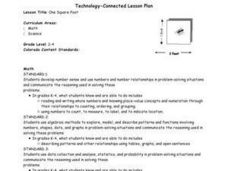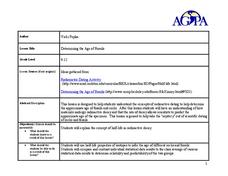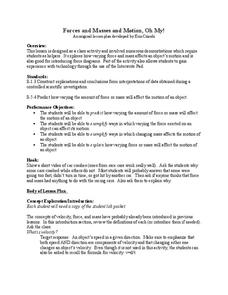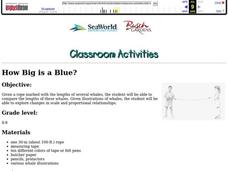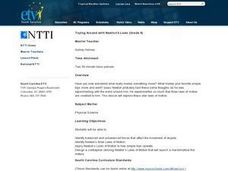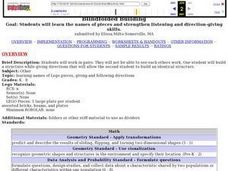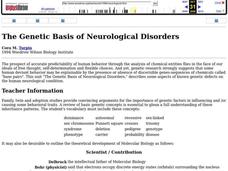Curated OER
Scavenger Hunt
Students collect data about lighting conditions around a room using a light sensor and RCX. They use software to upload and analyze the data in order to draw conclusions about light intensity in the room.
Curated OER
Point of View and Scientific Truth
Students investigate the mystery of the "destructive force." They explore the concepts of natural phenomena. Students discuss the limited aspects of natural phenomena and the "whole truth" to generate new hypotheses that can be tested.
Curated OER
Is It Likely or Is It Unlikely?
n a class discussion Students identify events or situations as being likely to occur or unlikely to occur. Then, they work in pairs to generate likely and unlikely statements to share with the class.
Curated OER
Creating The Virtual Model
Students engage in a lesson that is about the concept of earthquake design. The lesson includes the integration of technology and how it can be used to create buildings and structures for withstanding an earthquake. Students also define...
Curated OER
Introduction to Scatter Plots and Correlation
High schoolers examine the concept of scatter plots. They compare baseball statistics to locate the ones that correlate with winning, and identify the positive, negative, and no correlation in sets of data using MS Excel.
Curated OER
Natural Selection
Students practice calculating allele and genotype frequencies in the framework of a simple simulation using hard candy, calculators, and a worksheet. This lesson includes a three-page worksheet and an assessment question for conclusion.
Curated OER
One Square Foot
Young scholars identify, describe, count, tally, and graph life found in one square foot of land.
Curated OER
Cosmic Collisions and Risk Assessment
In groups, learners create their own scientific impact experiments using ordinary materials, and observe and measure results with a variety of impacting bodies and velocities.
Curated OER
Feedback and Flowcharts
Sixth graders explain what a negative feedback system is and they distinguish it from a positive feedback system. They describe examples of how negative feedback is used in both nature and technology. , Students define homeostasis, and...
Curated OER
Determining the Age of Fossils
Students examine the concept of radioactive dating. In this radioactive dating lesson, students investigate how to determine the ages of fossils and rocks as they learn about half-life radioactive decay.
Curated OER
Forces and Masses and Motion, Oh My!
Students explore how varying force and mass effect the motion of an object. For this motion lesson students participate in a class activity and demonstrations.
Curated OER
Severe Weather - Deciding Where to Live
Students recognize the variety and frequency of severe weather occurrences. They research the type of severe weather that may occur in their area as well as determine the frequency of occurrence.
Curated OER
Deep Blue: Exploring the Deep Ocean
Learners examine landforms. In this social studies lesson, students bounce a beach ball around in order to discover that seventy percent of the Earth is covered in water. Learners
Curated OER
Landscape Picture Map
Students design a landscape picture map. In this landscape picture mapping lesson, students understand when and why to use a landscape picture map. Students discuss landscape picture maps.
Curated OER
HOW BIG IS A BLUE?
Students compare the lengths of whales using different lengths of rope. They illustrate one whale in life-size proportion.
Curated OER
Toying Around with Newton's Laws
Eighth graders identify balanced and unbalanced forces that affect the movement of objects and Newton's three Laws of Motion. Students also design a contraption utilizing Newton's Laws of Motion that will launch a marshmallow five meters.
Curated OER
Testing the Waters
Students use test kits to measure the level of chlorine, iron, sulfide, and dissolved oxygen in tap (drinking) water and stream water. They post and evaluate the results of these water quality tests.
Curated OER
Putting Your Best Foot Forward
Third graders measure their feet and their parents' feet, record data on computer-generated graphs, and calculate and record mean, median, and mode.
Curated OER
Blindfolded Building
Learners build a Lego design and then work with a partner to reproduce that design. They guide the building of the reproduction by description only and then check their work.
Curated OER
The Genetic Basis of Neurological Disorders
Students explore neurological disorders. They examine the presence and absence of discernible genes. Students describe neruological diseases and draw faces of affected persons. They play a human neurology disorders learning game.
Curated OER
The Cycle of Life
Eighth graders search for rites of passage in their own lives and study rites of other cultural groups in Louisiana and around the world. They assess how to recognize moments of importance in people's lives and find meaning in the stages...
Curated OER
Tense Consistency
In this tense consistency exercise, students are given twelve sentences and asked to determine whether all parts of the sentence are written in the same tense. Students must correct the incorrect sentences.
Curated OER
Intermediate Sentence Completion Exercise 35
In this intermediate sentence completion exercise 35 worksheet, students working online, choose the correct word(s) to complete the sentence, with immediate feedback.
Curated OER
Leaf Patterns
First graders explore the existence of patterns in everyday items. In this science and math integrated lesson, 1st graders match leaves with a name word card and organize them into four patterns. This lesson includes a reading of And the...








